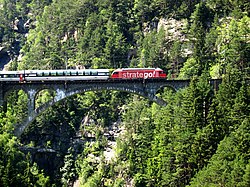
Back Schweizerische Bundesbahnen ALS السكك الحديدية الفيدرالية السويسرية Arabic سكك حديد سويسرا الفيدراليه ARZ Švicarske federalne željeznice BS SBB-CFF-FFS Catalan Švýcarské spolkové dráhy Czech SBB-CFF-FFS Danish Schweizerische Bundesbahnen German Ελβετικοί Ομοσπονδιακοί Σιδηρόδρομοι Greek Svisaj Federaciaj Fervojoj Esperanto
 Head office in Bern | |
Native name | Schweizerische Bundesbahnen SBB (German)[1] Chemins de fer fédéraux suisses CFF (French)[1] Ferrovie federali svizzere FFS (Italian)[1] Viafiers federalas svizras VFF (Romansh)[2][3][4][note 1] |
|---|---|
| Company type | state-owned AG/SA regulated by public law |
| Industry | Rail Transport |
| Founded | 1 January 1902 |
| Headquarters | , Switzerland |
Key people | Vincent Ducrot, CEO |
| Revenue | |
| Total assets | |
| Total equity | |
Number of employees | |
| Divisions | Passenger, SBB Cargo, Infrastructure, Real Estate |
| Website | sbb |
 SBB network (for the whole Swiss railway network see: Rail transport in Switzerland) | |
 InterCity on the old Gotthard Line | |
| Overview | |
|---|---|
| Dates of operation | 1 January 1902–present |
| Technical | |
| Track gauge | 1,435 mm (4 ft 8+1⁄2 in) standard gauge |
| Electrification | 99% 15, 1% 25 kV, 16.7, 50 Hz Overhead line |
| Length | 3,230 km (2,007.0 mi) |
Swiss Federal Railways (German: Schweizerische Bundesbahnen, SBB; French: Chemins de fer fédéraux suisses, CFF; Italian: Ferrovie federali svizzere, FFS)[1] is the national railway company of Switzerland.
The company, founded in 1902, is headquartered in Bern.[7] It used to be a government institution, but since 1999 it has been a special stock corporation whose shares are held by the Swiss Confederation and the Swiss cantons. It is currently the largest rail and transport company of Switzerland; it operates on most standard gauge lines of the Swiss network. It also heavily collaborates with most other transport companies of the country, such as the BLS, one of its main competitors, to provide fully integrated timetables with cyclic schedules.
SBB was ranked first among national European rail systems in the 2017 European Railway Performance Index for its intensity of use, quality of service, and safety rating.[8] While many rail operators in continental Europe have emphasised the building of high-speed rail, SBB has invested in the reliability and quality of service of its conventional rail network, on both national and regional scales. In addition to passenger rail, SBB operates cargo and freight rail service, through its subsidiary SBB Cargo, and has large real estate holdings in Switzerland.
- ^ a b c d "SR/RS 742.31 Bundesgesetz über die Schweizerischen Bundesbahnen (SBBG/LCFF/LFFS): Art. 2 Firma, Rechtsform und Sitz, §1" (federal law) (in German, French, and Italian). Berne, Switzerland: Federal Council: Federal Lex (fedlex). 20 March 1998. Retrieved 3 April 2023.
Unter der Firma «Schweizerische Bundesbahnen SBB, Chemins de fer fédéraux CFF, Ferrovie federali svizzere FFS» besteht eine spezialgesetzliche Aktiengesellschaft mit Sitz in Bern.
- ^ Cite error: The named reference
OfficialFederalAbbreviationswas invoked but never defined (see the help page). - ^ "TERMDAT - The terminology database of the Federal Administration: SBB" (official). Berne, Switzerland: Federal Chancellery. 16 November 2016. Retrieved 3 April 2023.
- ^ "Schweizerische Bundesbahnen". fedlex.data.admin.ch (official). Retrieved 4 April 2023.
- ^ a b c d "Facts and Figures – Finance 2022". Berne, Switzerland: Swiss Federal Railways. 2023. Retrieved 3 April 2023.
- ^ "Facts and Figures – Personnel". Berne, Switzerland: Swiss Federal Railways. 2023. Retrieved 3 April 2023.
- ^ "Imprint". Swiss Federal Railways. Retrieved 2 February 2022.
Swiss Federal Railways SBB Passenger Services Markets Trüsselstrasse 2 3000 Berne 65 Switzerland
- ^ "the 2017 European Railway Performance Index". Boston Consulting Group. 18 April 2017.
Cite error: There are <ref group=note> tags on this page, but the references will not show without a {{reflist|group=note}} template (see the help page).
© MMXXIII Rich X Search. We shall prevail. All rights reserved. Rich X Search